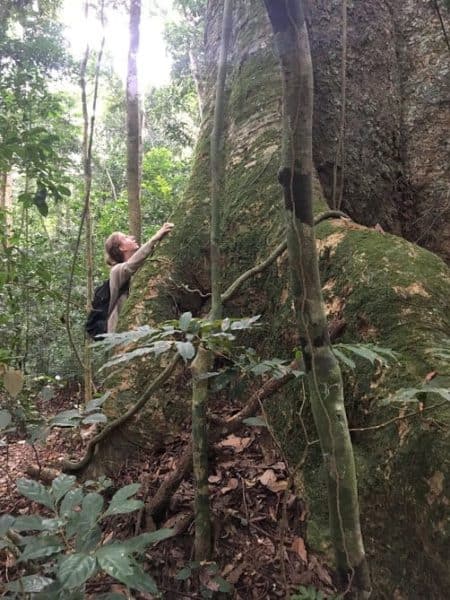Like wine, cheese, and savvy financial investments, many tropical trees become more valuable with age. This is particularly true when it comes to carbon storage, because old trees are often the biggest trees and the larger the tree, the more carbon it stores.
The value of big, old trees in combating climate change was underscored in a recent study of Gabon’s forests, led by the Nicholas School of the Environment’s John Poulsen. The team’s striking finding — that half of Gabon’s wealth of carbon is found in the largest 5% of trees — has implications that reach far beyond the sparsely populated Central African country’s borders.
Tropical forests play a key role in the global carbon cycle by keeping carbon out of the atmosphere. Trees take in CO2 — one of the infamous, heat-trapping greenhouse gases — during photosynthesis and use the carbon to grow, making new leaves, thicker and taller trunks, and more expansive root systems.
Scientists can estimate how much carbon a tree holds by measuring its trunk. So, like rainforest tailors, trained technicians traveled to all corners of the country to measure the girth and height of tens of thousands of trees.
This extraordinary two-year long effort was one of the first nationwide forest inventories in the tropics, making Gabon a leader in comprehensive forest monitoring.
Poulsen and collaborators used the tree measurements to estimate the amount of carbon stored in Gabon’s forests and to determine why some forests hold more carbon than others.
“The field techs deserve all the credit”, Poulsen explained, “as they often walked for days through thick forest, traversing swamps and enduring humid, buggy conditions to measure trees. We turned their sweat and toil into information that could be used by Gabon’s government to prioritize areas for conservation.”

The team analyzed a suite of environmental factors to see their effects on carbon storage. Of the natural factors, only soil fertility had a noticeable positive effect on tree biomass. Much more important was the impact of humans. As human activities such as agriculture and logging tend to target large trees, more heavily human-disturbed forests had a much different structure than pristine forests. The farther a study area was from human settlements, the more likely it was to host large trees and consequently, higher amounts of carbon.
The paper notes that Gabon stands out as a country with “one of the highest densities of aboveground forest carbon.” In fact, Gabon’s undisturbed forests store more carbon than those in the Amazon, which have been referred to as the lungs of the planet.
According to Poulsen, “Gabon is the second most forested country in the world with 87% forest cover, a deforestation rate near zero…” Because of its impressive forest cover and its location straddling the equator, Gabon’s forests host an incredibly diverse array of plants and animals, including many threatened and endangered species. Rural communities depend on these forests for their livelihoods.

However, Gabon’s impressive forests are valuable to more than just wildlife, climate researchers, and local communities. The logging industry also sees these forests as a chance for profit. More than half (about 67%) of Gabon’s forests are under contract with logging companies to harvest timber, putting them at risk of losing many of their carbon-storing giants.
Poulsen’s study highlights the importance of a more nuanced approach to forest conservation in Gabon. One that doesn’t simply focus on stopping deforestation or promoting restoration, as is prescribed in many international climate change plans, but an approach that recognizes the necessity of preserving high conservation value, old growth forests.
If our reporting has informed or inspired you, please consider making a donation. Every contribution, no matter the size, empowers us to continue delivering accurate, engaging, and trustworthy science and medical news. Independent journalism requires time, effort, and resources—your support ensures we can keep uncovering the stories that matter most to you.
Join us in making knowledge accessible and impactful. Thank you for standing with us!

